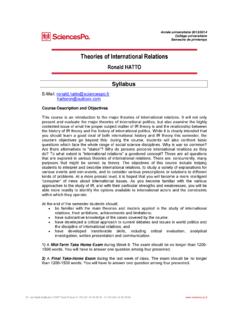Transcription of Household Saving in China - World Bank
1 Published in: World Bank Economic Review September 2000. Household Saving in China Aart Kraay*. The World Bank First Draft: November 1997. This Draft: May 2000. Abstract: China , the World 's largest and fastest-growing economy in recent years, has also experienced national Saving rates that are among the highest in the World . This paper considers a variety of statistical issues that cloud the measurement of aggregate and Household Saving in China , and provides new empirical evidence on the importance of intertemporal considerations in explaining inter-provincial variation in Household Saving in China . _____. *This paper was prepared as part of a World Bank research project entitled Saving Across the World : Puzzles and Policies . I am grateful to the project's organizers, Norman Loayza, Klaus Schmidt-Hebbel and Luis Serv n for their encouragement, and to Nick Lardy, Lihong Wang, the editor of this journal, and three anonymous referees for their helpful discussions. The views expressed in this paper are the author's, and do not necessarily represent those of the World Bank, its executive directors or the countries they represent.
2 1. Introduction China , the World 's largest and fastest growing economy in recent years, has also experienced Saving rates that are among the highest in the World . Since the first steps towards economic reforms were taken in 1978, China 's gross national Saving rate has averaged 37 percent of GNP, while its economy has expanded at a remarkable percent per year in per capita terms, lifting 200 million Chinese out of absolute poverty. Rapid growth has been accompanied by an equally-rapid process of transition, as China has progressed from a primarily rural, agrarian and state-run economy to a more urban and industrial society in which the majority of economic interactions are governed by market forces. These transitions have had profound consequences for Saving . Consider China 's transition from plan to market. Before 1978, China 's high Saving rates, averaging 27 percent of GNP, were engineered by state fiat. Distorted relative prices favoured industry, concentrating profits in state-owned enterprises which could then be directed towards the state's investment priorities.
3 Household incomes were very low, and households accounted for only a small proportion of total Saving . The advent of economic reforms has transformed the role of the public and private sectors in Saving . Price reform and vigorous competition from collectively-owned and private enterprises have eroded the operating surpluses of state industry, and with them the importance of public Saving . In contrast, rising Household incomes and rising Saving rates have brought Household Saving to new prominence, with households contributing between one-quarter and one-half of total Saving . Transition to market has not only given new importance to the voluntary consumption and Saving decisions of households, but it has also shaped the economic environment in which these decisions are made. In rural areas, the collapse of the agricultural commune system and the emergence of more secure property rights to land and buildings sparked a boom in rural Household Saving in the form of investment in land and housing.
4 In addition, the proliferation of bank branches into even remote areas and the rapid growth of rural industry has given rural households access to a broader range of assets. Urban households, once covered by generous cradle-to-grave benefits through employment in state-owned enterprises, are finding their futures increasingly 1. uncertain as the financial performance of their state-owned employers has weakened. At the same time, growth in the non-state sector has meant that a small but increasing share of urban workers no longer enjoy the same generous benefits afforded their counterparts in state industry. These factors have plausibly provided strong new Saving motivations for urban households. Furthermore, as incomes have risen from quite low levels, especially in rural areas, a decreasing share of income is being devoted to meeting subsistence consumption requirements, leaving more income available to act on these Saving motivations. Against this backdrop, this paper makes two contributions.
5 The first, while mundane, is important as it concerns measurement of Saving in China . As in many developing countries substantial statistical difficulties arise when measuring Saving . In China these difficulties are particularly acute. I discuss at some length discrepancies between aggregate Saving and its components, and between alternative measures of Household Saving , and discuss the implications of these for views of Saving in China . Second, I examine the relevance of standard forward-looking models of consumption and Saving for China . In particular, I provide new evidence on how expectations of future income growth and future income uncertainty, as well as demographic variables and proxies for the importance of subsistence consumption explain interprovincial differences in Household Saving rates. Consistent with the predictions of standard intertemporal models of consumption, I find that for rural households, higher future income growth is associated with lower current Saving rates, as households raise their consumption in anticipation of higher expected future income.
6 Somewhat puzzlingly, however, future income uncertainty does not appear to raise current Saving rates, as would be the case for prudent households with precautionary Saving motivations. Finally, there is a robust negative relationship between the share of food expenditures in total expenditures (a proxy for the importance of subsistence consumption) and Household Saving rates. While these results cannot explain why China 's overall Saving rates are so high, they do provide insights into the factors underlying the rural-urban, interprovincial, and intertemporal variations in Saving in China . Given China 's size and its high Saving rates, it is not surprising that considerable theoretical and empirical effort has been devoted in recent years to undestanding its Saving behaviour. This research can broadly be divided into two strands. The first has 2. emphasized the relevance for China of traditional equilibrium theories of Saving , ranging from simple Keynesian consumption/ Saving functions to variants of the life-cycle and 1.
7 Permanent-income hypotheses. The second has argued that equilibrium theories of Saving are unlikely to be relevant in an economy in transition from plan to market, and has instead argued that disequilibrium factors, especially shortages and rationing in 2. goods and credit markets can account for China 's Saving experience. These alternative hypotheses have been subject to empirical scrutiny using both aggregate and Household level data, with varying success. In addition to its treatment of data issues, this paper differs from much of the existing literature on China in that it directly tests the importance of expectations of future income growth and future income uncertainty, following the approach suggested by Carroll and Weil (1994) and Carrol (1994) in the and international contexts. The remainder of this paper proceeds as follows. The next section provides a description of trends in aggregate and Household Saving in China , and discusses measurement issues. Section 3 presents new evidence on determinants of Household Saving in China using a panel of province-level data from China 's Household survey.
8 Section 4 concludes with a discussion of the policy implications and directions for further research. A brief appendix provides additional information on the Household survey as well as. 1. Examples of these include estimates of simple Keynesian consumption or Saving functions (Wong (1993), Qian (1988), World Bank (1988)); tests of various implications of the permanent income hypothesis (Chow (1985), Qian (1988), Wong (1993), Wang (1995)); and tests of the life- cycle model (Jefferson (1990), Pudney (1991), Dessi (1991), Modigliani and Cao (1996)). Bai, Zhu and Wang (1993), Yusuf (1994), Zhang (1994), and Arora (1995) offer interesting descriptive analyses of Saving in China but do not formally test alternative theories of Saving . 2. See Feltenstein, Lebow and Van Wijnbergen (1990) and Ma (1993), as well as indirect evidence via the estimates of the effects of rationing in demand systems provided by Wang and Chern (1992) Fleisher, Liu and Li (1994) and Wang and Kinsey (1994).
9 Direct survey evidence on consumer goods availability can be found in Hussain, Ludlow, Wang and Wei (1990). Naughton (1987) provides a critical review of this evidence and suggests that involuntary Saving is unlikely to be empirically important other than possibly in the very early post-reform period. 3. 2. Measuring Saving in China According to national accounts data, Saving in China has been extraordinarily high over the past 20 years. In this section I briefly review this fact, and then present rough estimates of the composition of national and of Household Saving . This exercise highlights a number of data problems with important implications for the understanding of Saving in China that are frequently ignored in empirical work. Finally, I describe the panel of provincial Saving data based on Household surveys that is used in the following section. Measuring Aggregate Saving Over the past thirty years, official statistics for China reveal high and rising Saving rates, and rapid growth.
10 Between 1965 and 1977, gross national Saving rates averaged percent of GNP, climbing to an average of percent between 1978 and 1995. During these periods, per capita GNP growth averaged percent and percent, respectively, although the latter growth rate is probably overstated by 1 to 2 percentage points. This Saving and growth performance is similar to that of other rapidly-growing economies in East Asia, although China 's high Saving rates were reached at much lower 3. income levels. More striking is the discrepancy between China 's Saving experience and that of the transition economies of Eastern Europe and the Former Soviet Union. While China weathered the early stages of transition with only small declines in national Saving rates, many of the other transition economies saw sharp declines in national Saving rates mirroring the well-documented output collapse in these As discussed below, the resilience of China 's aggregate Saving rates throughout the transition process reflects the fact that Household Saving increased rapidly during the early years of reforms, offsetting the decline in publicly-directed Saving through the planning and state- enterprise apparatus.


















